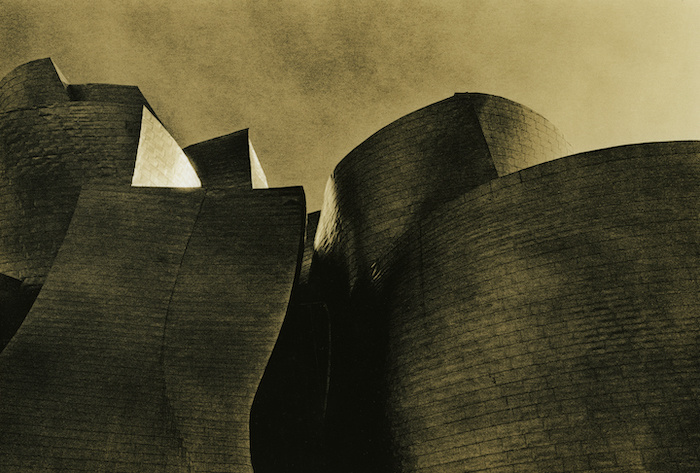Adrian Ensor: Master Printer's Eye
24 June - 27 August 2022 |
|
Adrian Ensor, Guggenheim Bilbao © Adrian Ensor
|
|
Adrian Ensor is a master printer and fine art photographer based in Fitzrovia, London. He has practiced darkroom printing for over 50 years and has been recognised as one of Britain's finest black and white photographic printers. Ensor has also become known as a fine art photographer in recent years although his own photographic practice spans many years. His photographs are produced using his outstanding knowledge and experience as a professional darkroom printer, his love of other forms of art including painting, literature and music, and inspiration from people that he has encountered. For this exhibition at Aperture Gallery, we showcase a wide range of Ensor’s photographs with a selection from different groups of works representing various aspects of his artistic character. His own photographic practice began over 30 years ago, with the loss of his dog Billy, which took him back to the walking route he used to take with Billy, with his camera. Each photograph from the series Billy’s Walk makes one imagine Ensor’s personal memories with Billy against the background of idyllic West Yorkshire landscapes. The series is the most personal and emotional among Ensor’s other series, and resonates with the universal experience of losing loved ones and the healing of one’s grief from it. People’s stories have always inspired Ensor and taken him to various places, with his camera, of course. These pictures were grouped in the series The Journey. The journey to the island of Inishmeane off the Donegal, Ireland, for example, was prompted by the story by Patrick O’Donnell who he met in his local pub in Fitzrovia. He told Ensor that even 10 years since his father’s death, his suit was still hanging in the wardrobe in his house on the island. Ensor traveled to the island later and took a photo of that suit. Many photographs from this series are accompanied by stories like this one. At other times, fellow artists led his way. The encounter between Ensor and the Belgian coastal town Ostend was prompted by Ensor’s interest in the painter and his namesake James Ensor, who was born in the town. The beach subject and its composition, however, are rather more directly influenced by another painter from Ostend, Léon Spilliaert. In particular, the beach scene, shot at night exclusively by streetlights, with its absorbing dark sea and waves rendered as pale clouds by long exposures, is reminiscent of Spilliaert's recurring night-time seascapes. After returning from Ostend, Ensor continued to explore night photography in London among the monuments and iconic buildings that adorn the city. These landmarks, which during the day tend to be lost in the hustle and bustle of the busy city, take on a kind of eerie life by the light effects of limited street lighting and dramatic angles. Like the beach in Ostend, these night images from Monumental London series reveal a different character for something familiar to many. The series Lorca was shot in Fuente Vaqueros and the surrounding Vega in the province of Granada, Spain, the birthplace of the Spanish poet Federico García Lorca between 1999-2005. Interestingly, Ensor had never read the poet’s works before he shot these photographs. These images, however, still invite the audience to imagine the scenery that might have fostered Lorca’s passion for art and politics. As Ensor’s first solo exhibition in an institution, the exhibition will be shown from the 3rd of June to the 30th of December 2022 at Centro de Estudios Lorquianos, Fuente Vaqueros. Architecture photographs articulate Ensor’s photographic techniques in another way. The photographs of the Guggenheim Museum, in particular, create very unique images of the world-famous building by daring to focus on parts, take extreme angles and emphasise texture. For this series, Ensor used a lith developer and Oriental Seagull paper to achieve a contrasty and grainy look. The same paper is no longer available, making these prints even more precious. When Ensor came across Varengeville-sur-Mer in North France, he fell in love with these rocks fallen from the cliff to the below beach. For him, those quirky-shaped rocks were the perfect objects to express contrast, texture, and the effect of light and shadow on, making the series a summarisation of his photographic work.
Adrian Ensor Adrian Ensor was born in South Woodford, Essex. He first started his photographic career at the age of 15 by helping his uncle who was a wedding photographer. In 1970 he started working in Primrose Hill Studios in Fitzrovia. In 1971, he opened his own studio on Grafton Way, where he still works after 50 years. As a printer, he has worked with many acknowledged photographers including Clive Arrowsmith, Cecil Beaton (archive), John Claridge, Terry Donovan (archive), Brian Duffy, Hamish Fulton, Richard Long, Gerard Mankowitz, Terry O’Neil, Ketaki Sheth, John Stoddart, and David Ward. Ensor is the author of Advanced Processing and Printing RotoVision SA, 2001), a highly-acclaimed bible of darkroom printing. Ensor’s photographic works have been shown at Ilford Gallery (London, 1996), Sewerby Hall (Yorkshire, 1997), London Architectural Association (London, 1999), Glasgow School of Art (Glasgow, 2000), Photographer’s Gallery (London, 2003), and Royal Academy of Art’s Summer Exhibition (London, 2013), and he has had solo exhibitions at Framers Gallery (London, 2012 and 2019) and Fitzrovia Chapel (London, 2021). In 2022, he has his first solo exhibition in an institution “On the Trails of Lorca” at Centro de Estudios Lorquianos (Fuente Vaqueros, Spain), which features his series inspired by the life of the Spanish poet.
|

